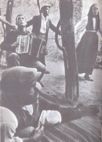Spiders, songs and suffering in Salento
We go to the deep south of Italy where magic mixes with religion and celebration with suffering in a time-worn dance of the soul
 When anthropologist Ernesto De Martino carried out his now famous study into tarantismo (the mythical spider's bite experienced by some women which could only be cured by a frenzied dance) in the Salento area in the summer of 1959, few people could have envisaged his findings which were published in 1961 in his book La terra del rimorso (The Land of Remorse - rimorso also means bitten again -ed.). De Martino's team carried out their research in Nardo, Galantina, Maglie and other small towns and villages in the deep south of Apulia. Their work unveiled an ancient culture where Christianity was directly linked to primitive pagan traditions.
When anthropologist Ernesto De Martino carried out his now famous study into tarantismo (the mythical spider's bite experienced by some women which could only be cured by a frenzied dance) in the Salento area in the summer of 1959, few people could have envisaged his findings which were published in 1961 in his book La terra del rimorso (The Land of Remorse - rimorso also means bitten again -ed.). De Martino's team carried out their research in Nardo, Galantina, Maglie and other small towns and villages in the deep south of Apulia. Their work unveiled an ancient culture where Christianity was directly linked to primitive pagan traditions.De Martino refused to interpret the tarantula's bite literally but as part of a greater truth that is lodged in our subconscious and which effects our behaviour, beliefs and culture. The frenzied dances which were traditionally prescribed as a cure for the spider's poison are - according to De Martino's book - a way of expressing, and maybe even curing very different ailments.
Back in the 17th Century the Jesuit priest Athanasius Kircher wrote enthusiastically in his Musurgia universalis about the therapeutic quality of music in recovering from tarantula bites. Kircher, unlike De Martino, doesn't attempt a complex anthropological explanation, but rather concentrates on the power of music as a universal healing force describing a wounded microcosm which can only be cured through the gift of sound. The most famous of the refrains Kircher quotes is Antidotum tarantulae, a melodic piece which is undoubtedly beneficial to those of a melancholic disposition. "It was wonderful to see how these songs could ease emotions such as sadness, love, anger and revenge."
Numerous studies on tarantismo were carried out after Kircher but nothing significant emerged until the advent of De Martino who demystified the phenomenon placing it in a socio-cultural context where the bite (morso) transforms into remorse (rimorso) as the people become aware of their plight. All the repressed suffering of the working class explodes in the frenzied dances of the tarantate (the women supposedly bitten by the spider) and the hopelessness of their existence is abandoned for a few days.
 The earth, magic, culture, celebration and religion fuse together in one ritual which uses music - or to be more precise the pizzica tarantata - as its binding force. An entire people awaken to their state of suffering thanks to the tarantula's bite only to be delivered to collective freedom through the therapeutic beat of the music.
The earth, magic, culture, celebration and religion fuse together in one ritual which uses music - or to be more precise the pizzica tarantata - as its binding force. An entire people awaken to their state of suffering thanks to the tarantula's bite only to be delivered to collective freedom through the therapeutic beat of the music.Nowadays the pizzica tarantata no longer carries out the social function identified by De Martino, but has become part of a local musical tradition in the able hands of groups such as Ajara, Lu rusciu nosciu, Aramirè and Terrenure. While the dances have been claimed by the traditional festivals which are held at the end of June and around the 15th of August.